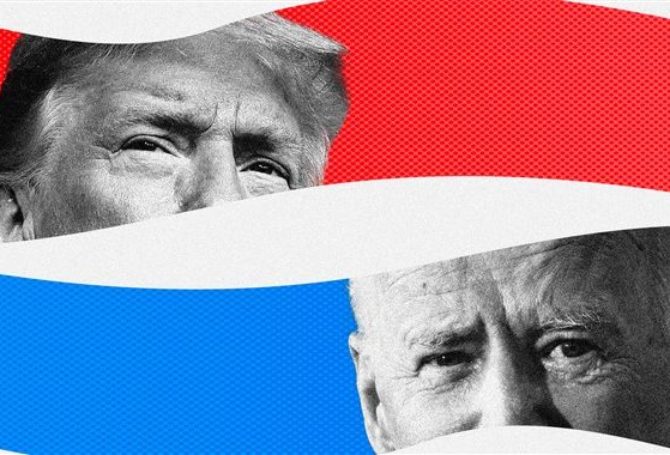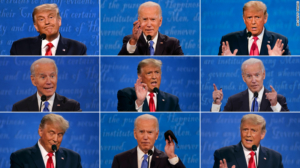
The 2020 presidential debates won’t go down in history as classics. The first was chaotic, the second was cancelled and the third was less heated, but only modestly informative. In an age of cable television and digital media, some observers wonder whether the live debate format has run its course.
That course began in 1948 in Oregon when Republican presidential hopefuls Thomas Dewey and Harold Stassen debated live on radio. Eight years later, Democratic primary rivals Adlai Stevenson and Estes Kefauver debated live on television.
The first live presidential debate occurred on November 4, 1956 on CBS’ Face the Nation. Ironically, it didn’t feature the two presidential candidates, President Eisenhower and Stevenson, his Democratic challenger. Instead, both were represented by surrogates, both of whom were women. Maine Senator Margaret Chase Smith spoke for Eisenhower while Stevenson was represented by his staunchest advocate, Eleanor Roosevelt. Smith invented the closing statement for the debate, to the annoyance of Roosevelt who didn’t have one.
Presidential debates hit prime time in 1960 when John F. Kennedy and Richard Nixon squared off in what would be the first live televised encounter featuring the actual candidates. The first of four debates proved the most consequential. The young, charming senator from Massachusetts came across as cool, while Nixon seemed stiff and looked pale. Nixon’s performance ended the debate over whether politicians should don television makeup. Historians credit a more TV-conscious Nixon with winning the second and third debates, but viewership was lower than the impression-setting first debate that boosted Kennedy’s prospects.
The next presidential debate didn’t occur until 1976 when President Gerald Ford agreed to face challenger Jimmy Carter in a series of debates sponsored by the League of Women Voters, as opposed to television networks. The first debate was marred by a technical glitch that interrupted audio in the middle of a Carter response. The candidates stood by until the problem was fixed, just in time for their closing statements.
Observers at the time believed Ford’s performance in the first debate enabled him to cut into Carter’s early lead in the presidential race. However, Ford’s fate was sealed in the second debate, which was devoted to foreign policy, when he misspoke about Soviet domination in Eastern Europe.
News media is saturated with presidential election coverage, from their speeches and position papers to opinion pieces on their speeches and position papers. You have to be in virtual seclusion not to know the most minute details of a presidential race.
Four years later when Carter sought re-election, he balked at appearing in a three-way debate with GOP challenger Ronald Reagan and John Anderson, who was running as an independent. The first debate went on as scheduled, but without Carter. The second debate was cancelled and the third debate featured a match-up between just Reagan and Carter. Reagan’s experience as an actor conveyed a confidence that was a factor in his landslide victory.
In 1984, Reagan wryly dismissed Democratic challenger Walter Mondale with his line, “I am not going to exploit, for political purposes, my opponent’s youth and inexperience.” Pundits and Mondale conceded Reagan’s re-election was sealed by the comment.
Presidential and vice presidential debates have been a staple of primary and general elections since then, with varying formats, different approaches to moderators and changing sponsorship. The League of Women Voters withdrew as a debate sponsor in 1988 with this statement: “It has become clear to us that the candidates’ organizations aim to add debates to their list of campaign-trail charades devoid of substance, spontaneity and answers to tough questions. The League has no intention of becoming an accessory to the hoodwinking of the American public.”
Viewership of presidential debates has generally been strong. All four of the Kennedy-Nixon debates attracted more than 60 million viewers. The same was true in the 1976 Ford-Carter debates. The second debate in 1980 was viewed by more than 80 million people. The third debate in the 2016 contest between Donald Trump and Hillary Clinton attracted 71.6 million viewers and the first debate in 2020 between Trump and Joe Biden peaked at more than 73 million viewers. The third and final debate drew 63 million viewers over 15 different networks, topped by 14.7 million who viewed it on Fox News.
A pandemic and Trump’s unconventional style have made the 2020 presidential debates seem less relevant and more like an obligatory appearance at the Iowa State Fair than an essential avenue to appeal to voters.

When campaigns relied on buses, trains and airplanes to reach target audiences, debates served a unique purpose of putting the candidates side-by-side. Now that can be accomplished by split-screen television (which incidentally was employed out of necessity in the third debate in 1960 with Nixon in Los Angeles and Kennedy in New York).
Presidential candidates today can engage voters with an array of digital tools, including live streaming. Micro-targeting on social media enables campaigns to zero in on very specific cohorts of voters, with efficiency and without regard to geography. Trump mocks Biden for campaigning from his “basement”, perhaps without realizing that may be a better (and safer) political cockpit than holding rallies in airplane hangars.
News media is saturated with presidential election coverage, from their speeches and position papers to opinion pieces on their speeches and position papers. You have to be in virtual seclusion not to know the most minute details of a presidential race.
Websites provide a convenient, accessible way to assess a candidate’s views on issues. Critical and contrasting views are equally convenient and accessible. You don’t need a debate to decipher the nuances of a candidate’s view on touchy issues.
Polarization of the electorate has made overall positions on issues less important than issues of specific interest to various groups. Polarization also has undermined political discourse based on facts and reality, substituting alt-facts and conspiracy theories.
Huge presidential campaign budgets allow candidates to run hundreds of ads with sound bites, testimonials and positions on key issues. Television spots can be produced almost instantly to newsjack a hot topic.
All these communication advances have turned debates with fixed schedules and confining formats into monuments from the past. Sixty years ago, a live debate between two contrasting candidates was fresh, relevant and informative. Today, supporters of Trump and Biden sat through their debates with their fingers crossed that their candidate of choice wouldn’t make a cataclysmic mistake.
There will be another presidential contest four years from now, which gives America time to rethink the purpose, value and impact of presidential debates. Younger voters, many of whom no longer watch commercial television, will represent a more prominent part of the electorate. Perhaps presidential debates should adopt some of the media universe from that generation and not stick with the universe of mine.
We should heed the advice of Nicolette Cavallro, a college sophomore majoring in integrative neuroscience at Binghamton University in New York, who says, “Debates need to grow with our nation or become a thing of the past, especially if we want our presidential election process to remain intact.”




